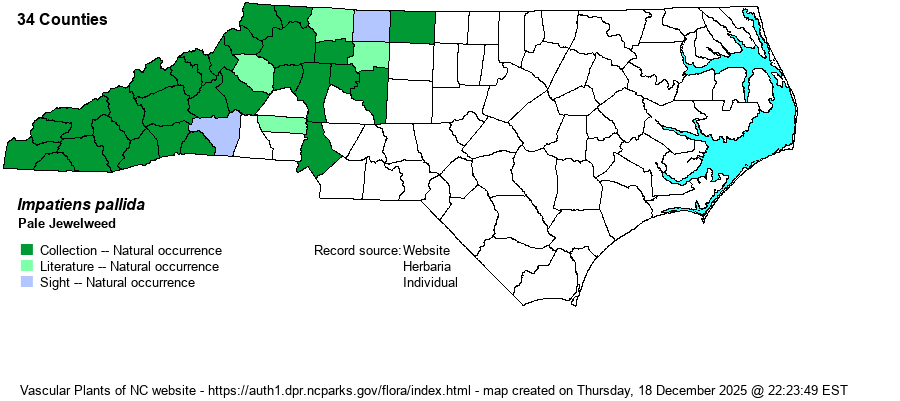| Author | Nuttall | |
| Distribution | Throughout the Mountains, and sparingly into the western half of the Piedmont, east to Rockingham, Davidson, and Mecklenburg counties.
This is a Northeastern species, ranging from eastern Canada south to western NC, northern AL, and northeastern OK. | |
| Abundance | Common throughout the Mountains, but uncommon to infrequent in the western half of the Piedmont. | |
| Habitat | This wetland species has similar habitats to that of I. capensis, but usually in higher pH soils. It grows in moist forests such as cove forests and bottomlands, along streams, and in bogs. |
| Phenology | Blooms from July to September, and fruits shortly after flowering. | |
| Identification | This familiar species is extremely similar to Spotted Jewelweed (I. capensis) vegetatively -- a smooth, robust stem growing to 5-6 feet tall, alternate leaves that are elliptical to ovate-elliptical, about 3-4 inches long and 2 inches wide, with crenate margins and a rounded base. The yellow flowers are trumpet-shaped with a wide opening, about 1-inch long and about 3/4-inch across at the opening, in small dangling axillary clusters, each horizontally facing. The capsules are tubular and about 4/5-inch long, greenish, and springing open suddenly to expel the seeds. I. capensis has orange flowers, but otherwise the two are quite similar. | |
| Taxonomic Comments | None
| |
| Other Common Name(s) | Yellow Jewelweed, Yellow Touch-me-not, Pale Touch-me-not. As with the other species, the four common names are about equally in use, and any of them will suffice and not be a poor choice. | |
| State Rank | S5 | |
| Global Rank | G5 | |
| State Status | | |
| US Status | | |
| USACE-agcp | FACW link |
| USACE-emp | FACW link |

